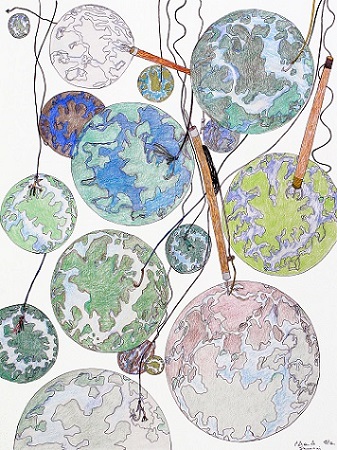Crippled Two-tongue and the Myth of Benign Translatability
DOI:
https://doi.org/10.25071/1925-5624.40315Resumen
Este es un relato en anishinaabemowin (también llamada lengua ojibwa). Se trata de una historia sobre los efectos incapacitantes que las traducciones eurocéntricas ejercen a través de procesos de redacción, reducción y refracción de sentidos. En este relato figuran polluelos cubiertos de heces fecales, buques del Imperio, un pantano, un Oráculo, un personaje lisiado de lengua bífida, otro “tradicional Nish”, una tarjeta de crédito falsa, y también un animal gigante, llamado Anishinaabemowin, al cual todos quieren devorar entero y no quieren compartir. Es una historia de dislocaciones forzadas y del asombroso viaje hacia la rearticulación de todas las partes de una lengua. Advertencia: en el curso de la redacción de este artículo unos cuantos polluelos sufrieron heridas narrativas pero al final salen bien librados.Citas
Anderson, Kim. A Recognition of Being: Reconstructing Native Womanhood. Toronto, ON: Second Story, 2000. Print.
Battiste, Marie Ann, and James Youngblood Henderson. Protecting Indigenous Knowledge and Heritage: A Global Challenge. Saskatoon: Purich Pub, 2000. Print.
Battiste, Marie Ann. Reclaiming Indigenous Voice and Vision. Vancouver: UBC Press, 2000. Print.
Bhabha, Homi K. The Location of Culture. London: Routledge, 1994. Print.
Daly, Mary, and Jane Caputi. Websters’ First New Intergalactic Wickedary of the English Language. Boston: Beacon, 1987. Print.
Deleuze, Gilles, and Félix Guattari. A Thousand Plateaus: Capitalism and Schizophrenia. Minneapolis: University of Minnesota Press, 1987. Print.
Ende, Michael. The Neverending Story. Trans. Ralph Manheim. Illust. Roswitha Quadflieg. Garden City, NY: Doubleday, 1983. Print.
Gebhardt, E. “Introduction to Part III. A Critique of Methodology.” The Essential Frankfurt School Reader. Eds. A. Arato and E. Gebhardt. New York: Continuum, 1982. 371-406. Print.
Hallett, Darcy, Michael J. Chandler, and Christopher E. Lalonde. “Aboriginal Language Knowledge and Youth Suicide.” Cognitive Development 22.3 (2007): 392-99. Web. DOI: https://doi.org/10.1016/j.cogdev.2007.02.001
Itwaru, Arnold, and Natasha Ksonzek. Closed Entrances: Canadian Culture and Imperialism. Toronto: TSAR Publications, 1994. Print.
Kiberd, Declan. Inventing Ireland: The Literature of the Modern Nation. London: Vintage, 1996. Print.
Loomba, Ania. Colonialism-postcolonialism. London: Routledge, 1998. Print.
Maracle, Lee. I Am Woman: A Native Perspective on Sociology and Feminism. Vancouver, BC: Press Gang, 1996. Print.
Norris, M. J. “Aboriginal Languages in Canada’s Urban Areas: Characteristics, Considerations and Implications.” Not Strangers in These Parts: Urban Aboriginal Peoples. Eds. Evelyn J. Peters and David Newhouse. Ottawa: Policy Research Initiative, 2003. Print.
Oliver, Michael. “The Politics of Disablement — Existing Possibilities.” The Politics of Disablement (1990): 95-111. Web. DOI: https://doi.org/10.1007/978-1-349-20895-1_7
Razack, S. H. “Timely Deaths: Medicalizing the Deaths of Aboriginal People in Police Custody.” Law, Culture and the Humanities 9.2 (2011): 352-74. Web. DOI: https://doi.org/10.1177/1743872111407022
Robinson, Douglas. “Tejaswini Niranjana, Retranslation, and the Problem of Foreignism.” Tradterm 4.2 (1997): 149-165. Web. DOI: https://doi.org/10.11606/issn.2317-9511.tradterm.1997.49857
Thomas, William Isaac, and Dorothy Swaine Thomas. The Child in America; Behavior Problems and Programs. New York: A.A. Knopf, 1938. Print.
Titchkosky, Tanya. “Disability Studies: The Old and the New.” Canadian Journal of Sociology / Cahiers Canadiens De Sociologie 25.2 (2000): 197. Web. DOI: https://doi.org/10.2307/3341823
Treuer, Anton. Living Our Language: Ojibwe Tales & Oral Histories. St. Paul, MN: Minnesota Historical Society, 2001. Print.
Descargas
Cómo citar
Número
Sección
Licencia

This work is licensed under a Creative Commons Attribution-NonCommercial-NoDerivs 3.0 Unported License.

